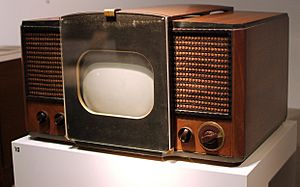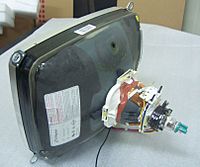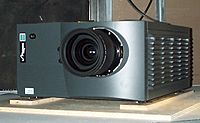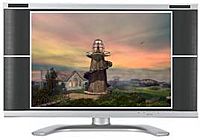Television set facts for kids
A television set, or TV, is a device that lets you watch and listen to TV shows. It's also used as a screen for computers or video game consoles. TVs first appeared in the late 1920s. After World War II, they became very popular. Early TVs used a technology called cathode ray tube (CRT).
In the 1960s, color TV made them even more popular. Soon, TVs became the main way to watch recorded movies on Betamax and VHS tapes. Later, DVDs took over. Since the 1980s, TVs have been used with home computers and video game consoles.
By the 2010s, most TVs became flat-panel screens. These use liquid-crystal display (LCD) technology, often with LED backlights. Modern flat TVs show very clear pictures, like 4K or 8K. They can also play content from a USB drive.
Contents
The History of Televisions
Let's look at how TVs have changed over the years.
Early TVs
Some of the first TVs were sold from 1928 to 1934. These were called mechanical TVs. They were often radios with a special device added. This device used a spinning disk and a neon light to make a small, red picture. The Baird "Televisor" was one of the first TVs sold to many people. About a thousand were sold in the UK.
In 1926, Kenjiro Takayanagi in Japan showed the first TV system using a cathode ray tube (CRT). This was the first TV that worked completely with electronics.
The first electronic TVs with CRTs were made in Germany in 1934. Other countries like France, Britain, and the US followed. A 12-inch TV cost about $445 in 1938. Before World War II, about 19,000 electronic TVs were made in Britain. Around 7,000 to 8,000 were made in the U.S.
After World War II, TV use grew very fast. Prices dropped, and people had more free time and money. In 1946, only 0.5% of U.S. homes had a TV. By 1962, 90% of homes had one!
Smaller, Portable TVs
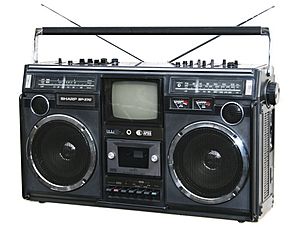
Early electronic TVs were big and heavy. They used vacuum tubes for their electronic parts. For example, an RCA color TV used 36 vacuum tubes!
In 1952, Sony founder Masaru Ibuka thought that new parts called transistors would make TVs smaller. The first fully transistorized, portable TV was the 8-inch Sony TV8-301. It came out in 1960.
By the 1970s, TVs became much smaller. Salespeople could easily carry them to show people in different areas. This helped more people get TVs. The first fully transistorized color TV was released in 1967. This change meant that watching TV became more of a personal thing, not just a group activity. By 1960, Sony had sold over 4 million portable TVs around the world.
By the late 1960s and early 1970s, color television became very common.
Flat-Screen LCD TVs
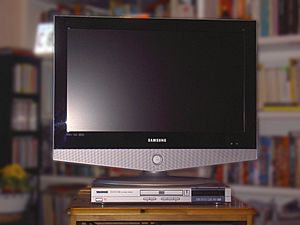
The idea for a liquid-crystal display (LCD) using thin-film transistors (TFT) came about in 1968. The first working TFT LCD was shown in 1973.
By 1982, small pocket LCD TVs were made in Japan. The 2.1-inch Epson ET-10 was the first color LCD pocket TV, released in 1984. In 1988, a team at Sharp Corporation showed a 14-inch full-color LCD screen. This made the electronics world believe that LCDs would replace cathode-ray tube (CRT) TVs. The first TV you could hang on a wall was introduced by Sharp in 1992.
In the early 2000s, flat-panel screens like plasma and LCDs started to replace CRT "picture tube" TVs. By the early 2010s, LCD TVs, especially those with LED backlights, were almost all the TVs being made.
TV Sizes Over Time
In 1967, Clive Sinclair made a mini TV that could fit in your hand. It was the smallest TV at the time. In 2019, Samsung launched the largest TV ever, at 292 inches (about 24 feet!). The average size of TVs has grown a lot over the years.
How TV Screens Work
TVs use different ways to show pictures. Today, LCD screens are the most common. OLED screens are also becoming more popular. Older types like plasma and CRT screens are no longer made.
Here are the main types of TV screen technologies:
- CRT (Cathode Ray Tube)
- LCD (Liquid Crystal Display) – This includes types like QLED, LED, IPS, and VA.
- OLED (Organic Light-Emitting Diode)
- Plasma
CRT Screens
A CRT is a special glass tube. It has an "electron gun" that shoots a beam of electrons. These electrons hit a screen coated with a special material that glows. This creates the TV picture. The electron beam moves very fast across the screen to draw the image.
CRTs were deep and heavy because they needed a lot of space inside. They also used thick glass to protect people from small amounts of x-rays that were made inside the tube.
DLP Screens
DLP stands for Digital Light Processing. It's a type of video projector technology. DLP uses tiny mirrors to create an image. Some DLP devices have a TV tuner, which means they can act as a TV. This technology was first developed in 1987.
DLP is used in many places. You can find it in projectors for classrooms and businesses. It was also used in some rear projection TVs. DLP is even used in about 85% of digital movie theater projectors!
Rear Projection TVs
Rear-projection televisions (RPTVs) were popular when it was hard to make very large TV screens. These TVs would project an image from a small screen onto a larger screen from behind. This made the TV much bigger.
In the early 2000s, RPTVs came back as a cheaper choice than flat LCD and Plasma TVs. They were bigger and lighter than old CRT TVs. They also had a flat screen. However, RPTVs were often dimmer and had less clear pictures than other TVs. They were still bulky, like CRTs. These TVs used a projector inside that bounced the image off a mirror onto the screen.
Plasma Screens
A plasma display panel (PDP) is a type of flat panel display. They were common for large TVs, 30 inches or bigger. Plasma TVs work by using tiny cells filled with electrically charged ionized gases. These gases glow to create the picture.
Around 2014, TV makers mostly stopped making plasma TVs. This was because they were more expensive and harder to make in 4K resolution compared to LED or LCD TVs.
LCD Screens
Liquid-crystal-display televisions (LCD TVs) use Liquid-crystal displays to make pictures. LCD TVs are much thinner and lighter than old cathode ray tube (CRT) TVs. They can also be made in much larger sizes, like 90 inches! As they became cheaper to make, LCDs became great for TVs.
In 2007, LCD TVs sold more than CRT TVs for the first time. They quickly became the most popular type of TV. By the mid-2010s, LCDs were by far the most common TV screen type.
However, LCDs do have some small weaknesses. Other technologies like OLEDs try to fix these.
OLED Screens
OLED stands for Organic Light-Emitting Diode. An OLED is a type of light-emitting diode (LED) that uses a thin film of organic compounds. This film glows when electricity passes through it. OLEDs are used to make digital displays for TVs, computer monitors, and mobile phones.
OLED screens don't need a separate light behind them (a backlight). This means they can show very deep black colors. They can also be much thinner and lighter than liquid crystal display (LCD) TVs. In a dark room, an OLED screen can look much better than an LCD.
Different Kinds of TVs
Most TVs are made for homes. But there are also special TVs for hotels, hospitals, and other businesses.
Hotel TVs
TVs made for hotels are part of a hotel's special TV system. Guests use them. These TVs often have hidden menus and settings that are locked with a password. They can also limit the volume and show a custom picture when turned on.
Hotels use these TVs to offer things like channel lists, movies you pay for, and streaming from phones. Many content providers require special protection for their shows. Hotel TVs can decode this protection. It's also easy to copy settings from one hotel TV to many others using a USB drive.
Hospital TVs
Hospital TVs have all the features of hotel TVs, plus more for safety and ease of use. They are made for people who might have trouble moving or seeing/hearing. A key feature is the pillow speaker connection. Pillow speakers combine a nurse call button, TV remote, and a speaker.
In rooms with many TVs, each TV can be set to respond to its own remote control. Smaller hospital TVs might have a full keypad below the screen. This lets patients use them without a remote. These TVs also have surfaces that fight germs and can be cleaned often with strong cleaners.
Outdoor TVs
Outdoor TVs are made to be used outside. You might see them in outdoor areas of bars, sports fields, or other public places. Most outdoor TVs are HDTVs. Their bodies are very strong. The screens are designed to be seen clearly even in bright sunlight. They also have special coatings to stop glare. They can handle different weather and often have anti-theft brackets.
Replacing Your TV
In the United States, people usually replace their TV every 6.9 years. But with new smart TV features and apps, people might start replacing them even sooner.
Recycling Old TVs
It's important to recycle old TVs properly. This is because of new rules about electronic waste. Recycling helps protect the environment from harmful materials. It also stops old TVs from ending up in landfills or being traded illegally.
Major TV Makers
Here are some of the biggest companies that made LCD TVs in 2016:
| Rank | Manufacturer | Market share (%) | Headquarters | |
|---|---|---|---|---|
| 1 | Samsung Electronics | 20.2 | Suwon, South Korea | |
| 2 | LG Electronics | 12.1 | Seoul, South Korea | |
| 3 | TCL Technology | 9 | Huizhou, China | |
| 4 | Hisense | 6.1 | Qingdao, China | |
| 5 | Sony | 5.6 | Tokyo, Japan | |
| 7 | Skyworth | 3.8 | Shenzhen, China | |
| 8 | Vizio Inc. | 3.7 | Irvine, United States | |
| 9 | Changhong | 3.2 | Mianyang, China | |
Images for kids
See also
 In Spanish: Televisor para niños
In Spanish: Televisor para niños
- 3D television
- Color television
- Digital video recorder
- Handheld television
- HDTV
- Home theater
- Smart TV


